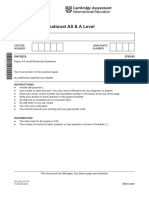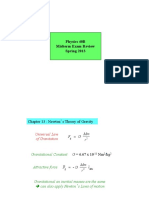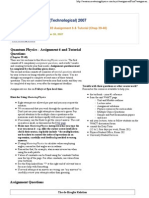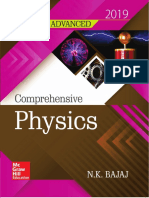IFY Physics EoS1 Test 2223 V2
IFY Physics EoS1 Test 2223 V2
Uploaded by
thecoolace9Copyright:
Available Formats
IFY Physics EoS1 Test 2223 V2
IFY Physics EoS1 Test 2223 V2
Uploaded by
thecoolace9Copyright
Available Formats
Share this document
Did you find this document useful?
Is this content inappropriate?
Copyright:
Available Formats
IFY Physics EoS1 Test 2223 V2
IFY Physics EoS1 Test 2223 V2
Uploaded by
thecoolace9Copyright:
Available Formats
IFYPH004 Physics
THE NCUK INTERNATIONAL FOUNDATION YEAR
IFYPH004 Physics
End of Semester 1 Test
Time Allowed
2 hour 40 minutes
1 INSTRUCTIONS TO STUDENTS
Questions Answer ALL questions. These questions carry 30 marks in
1-12 total (60% of the marks for this assessment).
Questions Answer 1 question ONLY. This question carries 20 marks in
13-14 total (40% of the marks for this assessment).
The marks for each question are indicated in square brackets [ ].
• Formulae are included in the front of the test booklet.
• Graph paper will be provided.
• An approved calculator may be used in the examination.
• Show ALL workings in your answer booklet.
• Test materials must not be removed from the test room.
• State the units where necessary.
• Where appropriate, working should be carried out to 4 significant figures and
answers given to 3 significant figures.
DO NOT OPEN THIS QUESTION PAPER UNTIL INSTRUCTED BY THE
INVIGILATOR
V2 2223 © 2023 Northern Consortium UK Ltd Page 1 of 12
IFYPH004 Physics
Data, formulae and relationships
Data
Speed of light in a vacuum c = 3.00 10 8 m s – 1
Gravitational constant G = 6.67 10 – 11 N m 2 kg – 2
Acceleration of free fall g = 9.81 m s – 2 (close to the Earth)
Gravitational field strength g = 9.81 N kg – 1 (close to the Earth)
Electronic charge e = – 1.60 10 – 19 C
Electronic mass me = 9.11 10 – 31 kg
Proton rest mass mp = 1.67 x 10-27 kg
Electron-volt 1 eV = 1.60 10 – 19 J
Planck constant h = 6.63 10 – 34 J s
Unified atomic mass unit u = 1.66 10 – 27 kg
Molar gas constant R = 8.31 J K – 1 mol – 1
Boltzmann constant k = 1.38 10 – 23 J K-1
Permittivity of free space o = 8.85 10 – 12 F m – 1
Coulomb Law constant k = 1 / ( 4 o ) = 8.99 10 9 N m 2 C – 2
Avogadro Constant NA = 6.02 10 23 mol-1
Absolute temperature T/K = θ/ºC+ 273.2
Rectilinear motion
For uniformly accelerated motion =u+at
s=ut+½at2
2= u2+2as
s = [½(u + v)] t
Materials and Elasticity
Density ρ = m/V
FL
Young's modulus E= = σ/ε
Ae
For a spring F = -kx
Energy E = ½Fx = ½kx2
Pressure change Δp = ρgΔh
Forces and moments
Moment of F about O = F (Perpendicular distance from line of action of F to O)
Dynamics and Energy
Kinetic Energy Ek = ½mv2
Gravitational Potential Energy Ep = mgh (near Earth’s surface)
V2 2223 © 2023 Northern Consortium UK Ltd Page 2 of 12
IFYPH004 Physics
p
Newton’s Law (for constant mass) F =ma=m =
t t
Impulse F t = p
Power P=F
Radioactive decay and the nuclear atom
Activity A=N
Half-life t ½ = ln 2
Radioactive decay A = A0e− t
N = N 0e − t
Electric current and potential difference
Q
Electric current I=
t
V
Resistance R=
I
Work W = QV = IVt
Electric power P = I 2 R = V2/R = IV
Electrical circuits
RA
Resistivity =
L
Resistors in series R=R1+R2+R3
1 1 1 1
Resistors in parallel = + +
R R1 R2 R3
Terminal potential difference V=–Ir
Heat
Change of state: Q = L m
Heating and cooling: E = mc
Change of internal energy: U = Q + W
Equation of State for ideal gas pV = nRT
pV = NkT
V2 2223 © 2023 Northern Consortium UK Ltd Page 3 of 12
IFYPH004 Physics
Circular motion and oscillations
Angular speed = =
t r
2
Centripetal acceleration a= = rω2
r
1 2
Period T= =
f
Simple Harmonic Motion
Displacement x = A sin( t )
Acceleration a = -ω2 x
Velocity v = A cos(t ) = ± ω √( A 2 - x 2)
l
For a simple pendulum T = 2
g
m
For a mass on a spring T = 2
k
Waves, Wave Motion and Interference
Malus’ law I = Iocos2ϴ
Wave speed v = fλ
Young's slits 𝑤 = 𝜆𝐷/𝑠
Diffraction grating d sinθ = nλ
Gravitational fields
Mm
Universal Law of Gravitation F =G
r2
Gravitational field strength g=F/m
Gravitational potential V=W/m
Electric fields
Q1Q2
F=
4 0 r 2
Coulomb’s law
Electrical potential V = Q/(4πεor)
Electric field strength E = F/Q
V2 2223 © 2023 Northern Consortium UK Ltd Page 4 of 12
IFYPH004 Physics
1 Q
For radial field E= (in free space or in air)
4 0 r 2
For uniform field E=V/d
Capacitance
Capacitance C=Q/V
Energy stored W = ½ C V 2 = ½ QV = ½ Q2/C
Capacitors in parallel C=C1+C2+C3
1 1 1 1
Capacitors in series = + +
C C1 C 2 C3
Time constant τ=RC
Capacitor discharge Q = Qoe-t/ τ, I = Io e-t/ τ, V = Vo e-t/ τ
Magnetic fields
Force on moving charge F = Bqv
Force on a wire F = BIL sin
Torque on a coil T = BIAn
Magnetic flux linkage NΦ = NBAcosθ
NΦ
E.m.f. induced in a coil = −
t
E.m.f. induced in a moving conductor = BLv
Modern Physics
Photon energy E = hf
Photoelectric effect hf = Φ + Ek max
h
De Broglie =
mv
Energy E = mc2
V2 2223 © 2023 Northern Consortium UK Ltd Page 5 of 12
IFYPH004 Physics
Mathematics
sin (90 o – ) = cos
ln (x n) = n ln x
ln (e kx) = k x
Equation of a straight line y = mx + c
Surface area of a cylinder =2rh+2r2
Surface area of a sphere =4r2
Volume of a cylinder = r 2h
Volume of a sphere = 4 r 3/ 3
For small angles sin tan (in radians)
cos 1
V2 2223 © 2023 Northern Consortium UK Ltd Page 6 of 12
IFYPH004 Physics
Questions 1-12
Answer ALL questions.
These questions carry 30 marks in total.
Question 1
What is the vertical component of the following force vector ?
[1]
A 16.9
B 36.3 N
C 36.3
D 16.9 N
Question 2
A stone of mass 0.1 kg is dropped off a cliff. How far does the stone travel [1]
in the 4th second? You can ignore the effect of air resistance.
A 19.8 m
B 34.3 m
C 44.1 m
D 78.5 m
Question 3
Which of the following is a vector quantity? [1]
A Momentum
B Energy
C Distance
D Speed
Question 4
The force acting on an object is equivalent to: [1]
A The impulse per second.
B The energy lost per second.
C The acceleration of an object per second.
D The change in momentum per second.
V2 2223 © 2023 Northern Consortium UK Ltd Page 7 of 12
IFYPH004 Physics
Question 5
A wire is stretched elastically by a force of 240 N causing an extension of [1]
3.0 mm. The force is then steadily increased to 320 N.
What is the new extension?
A 1.0 mm
B 2.0 mm
C 3.0 mm
D 4.0 mm
Question 6
A motor in a crane hoist lifts a load of 1500 kg through a height of 15 m at [1]
a constant velocity of 3 m s-1. The motor is 40% efficient.
What is the minimum input power to the motor?
A 265 k W
B 184 kW
C 17.6 kW
D 110 Kw
Question 7
A cathode ray tube fires 8.2 x 1015 electrons at a screen in 30 seconds. [1]
What current does this represent?
A 4.37 x 10-5 A
B 2.73 x 1014 A
C 3.66 x 10-15 A
D 2.11 x 10-6 A
Question 8
Three capacitors of equal capacitance C can be placed together in a circuit to [1]
give the effective capacitance of 2/3 C when:
A Two are in series with the third in parallel across this combination.
B Two are in parallel which are then in series with the third capacitor.
C All three are in parallel.
D All three are in series.
V2 2223 © 2023 Northern Consortium UK Ltd Page 8 of 12
IFYPH004 Physics
Question 9
A car which is moving at 20 m s-1 has a kinetic energy of E. [1]
The same car then moves at 30 m s-1.
The kinetic energy is now:
A 3/2E
B 2.25 E
C 10 E
D 0.5 E
Question 10
The specific latent heat of fusion of water is the amount of energy needed [1]
to:
A Melt a block of ice into a block of water.
B Boil a kilogram of water into steam.
C Freeze a kilogram of water into ice.
D Boil a litre of water.
Question 11
A block of wood of mass 4.5 kg is at rest on a horizontal, frictionless surface.
A force of 50 N acts on it for 0.3 s.
a) i. Determine the impulse of the force on the block of wood. [2]
ii. Determine the velocity the impulse gives to the block of wood. [2]
b) An object starting from the top of a smooth (frictionless) slope, inclined
at an angle of 20° to the horizontal, is given an initial velocity of
4.0 m s-1 down the slope.
i. Determine the time it will take for its velocity to reach a value of [2]
15.0 m s-1.
ii. Determine the distance travelled by the block in this time. [2]
iii. The total length of the slope is 40.0 m. Determine the velocity of [2]
the object as it reaches the end of the slope.
V2 2223 © 2023 Northern Consortium UK Ltd Page 9 of 12
IFYPH004 Physics
Question 12
a) i. Define resistivity of a material. [2]
ii. The resistivity of Nichrome is 1.10 x 10-6 Ω m. Determine the length [4]
of uniform Nichrome wire of circular cross section and a diameter of
0.18 mm that would be needed to make a resistor of resistance
20 Ω.
b) A voltmeter having a resistance that is very large compared to that
of the 6 Ω resistor, is connected directly across the terminals of a
cell and shows a reading of 3.2 V. Switch X is then closed so that
the 6 Ω resistor is connected in parallel with the voltmeter and the
reading falls to 2.6 V.
V
X
6Ω
i) Determine the e.m.f. of the cell. [1]
ii) Determine the internal resistance of the cell. [3]
V2 2223 © 2023 Northern Consortium UK Ltd Page 10 of 12
IFYPH004 Physics
Questions 13-14
Answer 1 question.
This section carries 20 marks in total.
Question 13
a) Define simple harmonic motion (SHM). [2]
b) A simple pendulum consists of a small spherical mass (the bob), attached
to the end of the length of string. The other end of the string is attached
to a fixed support. The bob is given a small displacement and released
to set the pendulum in motion. The bob can be considered to oscillate
with SHM.
i. What would happen to the time period of the pendulum if the bob [1]
was replaced by one of the same shape and size but made of a
material of twice the density?
ii. What would happen to the time period of the pendulum if the [1]
amplitude of the vibration was halved?
c) The pendulum has a length of 0.76 m and its vibration amplitude is
25 mm.
i. Determine the time period of the pendulum. [2]
ii. Determine the magnitude of the maximum velocity of the [2]
pendulum bob.
iii. At which position in the motion will this occur? [1]
iv. Determine the magnitude of the maximum acceleration of the [2]
pendulum bob.
v. At which position in the motion will this occur? [1]
vi. Sketch and label a graph of energy (y axis) against displacement [3]
(x axis) to show how the kinetic energy, potential energy and total
energy of the pendulum bob vary during one complete cycle of the
pendulum's motion.
vii. Determine the total energy of the bob if its mass is [2]
35 x 10-3 kg.
viii. Determine the new length of the pendulum when the frequency of [3]
the motion is 0.65 Hz.
V2 2223 © 2023 Northern Consortium UK Ltd Page 11 of 12
IFYPH004 Physics
Question 14
A car of mass 1280 kg starts from rest and readings of the car's velocity are
recorded every 5 seconds.
v/m s-1 0 4 8 12 12 12 6 0
t/s 0 5 10 15 20 25 30 35
a) i. Plot a graph of the car's velocity (y axis) against time (x axis). [4]
ii. Use the graph to calculate the acceleration of the car over the first 15 s. [2]
iii. Use the graph to determine the deceleration of the car over the final [2]
10 s.
iv. Use the graph to determine the total distance travelled by the car. [2]
v. Determine the maximum momentum of the car during the journey. [1]
b) A uniform plank of wood AB of mass 4 kg and 3 m long, is balanced so that
it rests in a horizontal position on two supports, C and D, as shown in the
diagram below. The first support is placed 1 m from end A and the distance
between the supports is 1.5 m.
An object of mass 8 kg is placed on the plank, with its centre of mass 1.6 m
from end A.
i. Determine the upward force provided by support C. [4]
ii. Determine the force provided by support D. [2]
iii. The object is gradually pushed towards end A. Determine the distance [3]
of the object from A when the plank just begins to lose contact with
support D.
- This is the end of the test. -
V2 2223 © 2023 Northern Consortium UK Ltd Page 12 of 12
You might also like
- Lower 6Document9 pagesLower 6Tinotenda MazhakataNo ratings yet
- Physics v1 1112 Final ProofDocument15 pagesPhysics v1 1112 Final Prooffarid oluwasegun SHITTUNo ratings yet
- Goldstein Solutions Chapter 8Document8 pagesGoldstein Solutions Chapter 8AmnishNo ratings yet
- MCAT FormulasDocument2 pagesMCAT Formulasdjanisz2100% (3)
- Classical MechanicsDocument19 pagesClassical MechanicsHiram K. HerreraNo ratings yet
- IFY Physics EoS1 Test 2223 V1Document13 pagesIFY Physics EoS1 Test 2223 V1thecoolace9No ratings yet
- Physics Exam V3 1617Document16 pagesPhysics Exam V3 1617lydiaisthegreatestNo ratings yet
- Physics Exam 1819 V2Document16 pagesPhysics Exam 1819 V2lydiaisthegreatestNo ratings yet
- Physics Exam V1 1617Document16 pagesPhysics Exam V1 1617lydiaisthegreatestNo ratings yet
- Physics Exam V2 1617Document16 pagesPhysics Exam V2 1617lydiaisthegreatestNo ratings yet
- Physics Exam V4 1617Document16 pagesPhysics Exam V4 1617lydiaisthegreatestNo ratings yet
- Physics EoS1 1819 V2Document12 pagesPhysics EoS1 1819 V2farid oluwasegun SHITTUNo ratings yet
- Physics Exam V3 1718Document16 pagesPhysics Exam V3 1718lydiaisthegreatestNo ratings yet
- Physics Exam V4 1718Document16 pagesPhysics Exam V4 1718lydiaisthegreatestNo ratings yet
- Physics Exam V5 1718Document16 pagesPhysics Exam V5 1718lydiaisthegreatestNo ratings yet
- Physics Exam V2 1718Document16 pagesPhysics Exam V2 1718lydiaisthegreatestNo ratings yet
- Fis 24Document6 pagesFis 24syafrina novitaNo ratings yet
- Physics v2 1213 FINALDocument15 pagesPhysics v2 1213 FINALfarid oluwasegun SHITTUNo ratings yet
- Cambridge International AS & A Level: PHYSICS 9702/04Document26 pagesCambridge International AS & A Level: PHYSICS 9702/04sinting lim100% (1)
- Physics A2 FormulasDocument7 pagesPhysics A2 Formulasdevasanisaiteja2006No ratings yet
- 2023 BPH OanswerbookletsDocument18 pages2023 BPH Oanswerbookletsliumeilin20070625No ratings yet
- IMportant Formulae 10 HijDocument2 pagesIMportant Formulae 10 HijRainbow SkyNo ratings yet
- Cambridge International AS & A Level: PHYSICS 9702/42Document24 pagesCambridge International AS & A Level: PHYSICS 9702/42k24xnzp2qyNo ratings yet
- Paper 4 CombinedDocument1,028 pagesPaper 4 CombinedPeter TaremwaNo ratings yet
- IB Physics Data BookletDocument16 pagesIB Physics Data Bookletzoe campbellNo ratings yet
- Cambridge International AS & A Level: PHYSICS 9702/43Document24 pagesCambridge International AS & A Level: PHYSICS 9702/43Ramadhan AmriNo ratings yet
- AP Physics 1 - Formula SheetDocument2 pagesAP Physics 1 - Formula SheetRunze LiNo ratings yet
- Physics Year 11 - Formulae and Constants SheetDocument2 pagesPhysics Year 11 - Formulae and Constants SheetbulboolhussainNo ratings yet
- Physics A2 FormulasDocument6 pagesPhysics A2 FormulaszferhanamjedNo ratings yet
- Phys 10010 Formula Sheet Modified For 2018 Rev 8Document4 pagesPhys 10010 Formula Sheet Modified For 2018 Rev 8Ayşegül AbdelalNo ratings yet
- Phy Formulae EDocument3 pagesPhy Formulae E779720 cNo ratings yet
- Physics - NotesDocument4 pagesPhysics - Notesiremkis079No ratings yet
- Cambridge International AS & A Level: PHYSICS 9702/42Document24 pagesCambridge International AS & A Level: PHYSICS 9702/42Công Phạm BáNo ratings yet
- Midterm Review PDFDocument16 pagesMidterm Review PDFMt RushNo ratings yet
- Uhorwfvnuohrafvn 8 Honvrf 8 UDocument24 pagesUhorwfvnuohrafvn 8 Honvrf 8 Uk24xnzp2qyNo ratings yet
- Physics 9702 Paper 4Document32 pagesPhysics 9702 Paper 4Alvin VictorNo ratings yet
- Cambridge International AS & A Level: PHYSICS 9702/42Document24 pagesCambridge International AS & A Level: PHYSICS 9702/42Ramadhan AmriNo ratings yet
- Cambridge International AS & A Level: PHYSICS 9702/42Document32 pagesCambridge International AS & A Level: PHYSICS 9702/42derekloh999No ratings yet
- 9702 w22 QP 43 PDFDocument24 pages9702 w22 QP 43 PDFsangdeepNo ratings yet
- 2022 JPJC Prelim H2 Physics P1Document15 pages2022 JPJC Prelim H2 Physics P1larrystan139No ratings yet
- Year 11 Formula SheetDocument5 pagesYear 11 Formula SheetJosh GreenNo ratings yet
- L2 Phys 2021 P2Document20 pagesL2 Phys 2021 P2Magd O.No ratings yet
- ASRJC H2 Physics MYCT 2022 MCQDocument20 pagesASRJC H2 Physics MYCT 2022 MCQclarissa yeoNo ratings yet
- 2023 JC1 H2 Physics SummaryDocument30 pages2023 JC1 H2 Physics SummaryWei QiNo ratings yet
- CJC JC1 Promo 2008 AnswersDocument25 pagesCJC JC1 Promo 2008 AnswerscjcsucksNo ratings yet
- Advanced Beam Dynamics & Hamiltonian Formalism: Rick Baartman, TRIUMF January 29, 2015Document23 pagesAdvanced Beam Dynamics & Hamiltonian Formalism: Rick Baartman, TRIUMF January 29, 2015s gNo ratings yet
- Cambridge International AS & A Level: PHYSICS 9702/41Document24 pagesCambridge International AS & A Level: PHYSICS 9702/41with love, alisha.No ratings yet
- AP Physics 1: Algebra-Based 2016 Free-Response QuestionsDocument10 pagesAP Physics 1: Algebra-Based 2016 Free-Response QuestionsLinrui LongNo ratings yet
- A Guide To Equations & Formulae For Physics: LTSN Physical Sciences WWW - Physsci.ltsn - Ac.ukDocument5 pagesA Guide To Equations & Formulae For Physics: LTSN Physical Sciences WWW - Physsci.ltsn - Ac.ukseetharamannNo ratings yet
- 2009 AP C MechanicsDocument22 pages2009 AP C MechanicsferhatyasarerginNo ratings yet
- Cambridge International AS & A Level: PHYSICS 9702/42Document28 pagesCambridge International AS & A Level: PHYSICS 9702/42abeehawaqas866No ratings yet
- H2 Physics: Raffles Institution 2022 Year 6 Term 3 Common TestDocument8 pagesH2 Physics: Raffles Institution 2022 Year 6 Term 3 Common Testxu.sichang.2023No ratings yet
- Physics 1 Equations and TermsDocument2 pagesPhysics 1 Equations and Termsdr.pp.3200No ratings yet
- Ap Physics 1 Equations Table 4Document2 pagesAp Physics 1 Equations Table 4gracia tNo ratings yet
- Ap Physics 1 Equations TableDocument2 pagesAp Physics 1 Equations TableShah Jahan KhattiNo ratings yet
- A2 Physics 9702 Paper 4 FinalDocument30 pagesA2 Physics 9702 Paper 4 FinalMusic GidrosiaNo ratings yet
- Edit Theory 9702 s23 QP 41Document21 pagesEdit Theory 9702 s23 QP 41anitajohnson.prakriyaNo ratings yet
- Solved 9702 - w22 - QP - 42Document24 pagesSolved 9702 - w22 - QP - 42umulbaninscNo ratings yet
- Aftab Saad: Cambridge International AS & A LevelDocument24 pagesAftab Saad: Cambridge International AS & A LevelMerandaNo ratings yet
- Feynman Lectures Simplified 2B: Magnetism & ElectrodynamicsFrom EverandFeynman Lectures Simplified 2B: Magnetism & ElectrodynamicsNo ratings yet
- Feynman Lectures Simplified 2C: Electromagnetism: in Relativity & in Dense MatterFrom EverandFeynman Lectures Simplified 2C: Electromagnetism: in Relativity & in Dense MatterNo ratings yet
- The Spectral Theory of Toeplitz Operators. (AM-99), Volume 99From EverandThe Spectral Theory of Toeplitz Operators. (AM-99), Volume 99No ratings yet
- Berg Uncertainty PrincipleDocument20 pagesBerg Uncertainty PrincipleSiddhi Nitin Mahajan0% (1)
- BL-NSCI-121-LEC-1922S PHYSICAL Science /for Antips: Question TextDocument236 pagesBL-NSCI-121-LEC-1922S PHYSICAL Science /for Antips: Question TextAlliah PesebreNo ratings yet
- 1 Physics Unit PlanDocument13 pages1 Physics Unit PlanT. Danielle DockeryNo ratings yet
- First Semester: Faculty of Engineering Department of Mechanical EngineeringDocument27 pagesFirst Semester: Faculty of Engineering Department of Mechanical Engineeringozoemena29No ratings yet
- Momentum Theory QP EasyDocument9 pagesMomentum Theory QP Easypr3z22cNo ratings yet
- Jee Advance TMHDocument1,220 pagesJee Advance TMHDevender Baghel100% (7)
- JSTSE Science-Math Paper 16 - 17 Aryan ClassesDocument23 pagesJSTSE Science-Math Paper 16 - 17 Aryan ClassesacNo ratings yet
- CRITICAL JURNAL Review (Bahasa Inggris Fisika)Document10 pagesCRITICAL JURNAL Review (Bahasa Inggris Fisika)Putra Rizky100% (1)
- Nios Class 12th Questions PhysicsDocument130 pagesNios Class 12th Questions PhysicsmokayeNo ratings yet
- Phys 3106Document8 pagesPhys 3106myo htetNo ratings yet
- FourDocument19 pagesFourSubhay kumarNo ratings yet
- Edexcel GCSE Additional Science Topic P2.2 Controlling and Using Electricity Test 15 - 16 With Mark SchemeDocument22 pagesEdexcel GCSE Additional Science Topic P2.2 Controlling and Using Electricity Test 15 - 16 With Mark SchemePaul Burgess100% (1)
- The SIMPLE Algorithm For Pressure-Velocity Coupling: ME 448/548 NotesDocument26 pagesThe SIMPLE Algorithm For Pressure-Velocity Coupling: ME 448/548 NotesDuílio Ferronatto LeiteNo ratings yet
- Chapter5 Momentum and Impulse StudentDocument25 pagesChapter5 Momentum and Impulse StudentHema JothyNo ratings yet
- 3500+ General Science MCQ EBOOK For LI, FORESTER, FORESTDocument321 pages3500+ General Science MCQ EBOOK For LI, FORESTER, FORESTsiba1986No ratings yet
- Igcse Science Syllabi (Chemistry, Physics) - Third Term GridDocument41 pagesIgcse Science Syllabi (Chemistry, Physics) - Third Term GridJomon ThomasNo ratings yet
- 9646 - 2013 Physics H2Document32 pages9646 - 2013 Physics H2Irene ArieputriNo ratings yet
- MIT ProblemsDocument29 pagesMIT ProblemsDe Nicolas JaidarNo ratings yet
- WWW - Ib.academy: Study GuideDocument95 pagesWWW - Ib.academy: Study GuideGag PafNo ratings yet
- Conceptual Energy Hewitt-2Document21 pagesConceptual Energy Hewitt-2nosferatu123456No ratings yet
- 3 PDFDocument31 pages3 PDFSebastian LopezNo ratings yet
- Rotating Packed Be DCF DDocument14 pagesRotating Packed Be DCF DkumarNo ratings yet
- ScienceDocument21 pagesScienceSweet EmmeNo ratings yet
- Phy 101-1Document101 pagesPhy 101-1Simon AdediranNo ratings yet
- GE6253-Engineering Mechanics Qustion BankDocument20 pagesGE6253-Engineering Mechanics Qustion Banknanthakumar91100% (1)
- DYNAMICS QUESTIONS For JEEDocument25 pagesDYNAMICS QUESTIONS For JEEAdarsh DhawanNo ratings yet
- Jee Main - (One Year Crp-2425) C-Lot-Ph-1 (Vec, KM, Lom, Wep & Com)Document20 pagesJee Main - (One Year Crp-2425) C-Lot-Ph-1 (Vec, KM, Lom, Wep & Com)baibhab07naiya2010No ratings yet
- Module 1 - Phys 13e Content Introduction MeasurementsDocument49 pagesModule 1 - Phys 13e Content Introduction MeasurementsRamnuj Orecul SoralcNo ratings yet

























































































